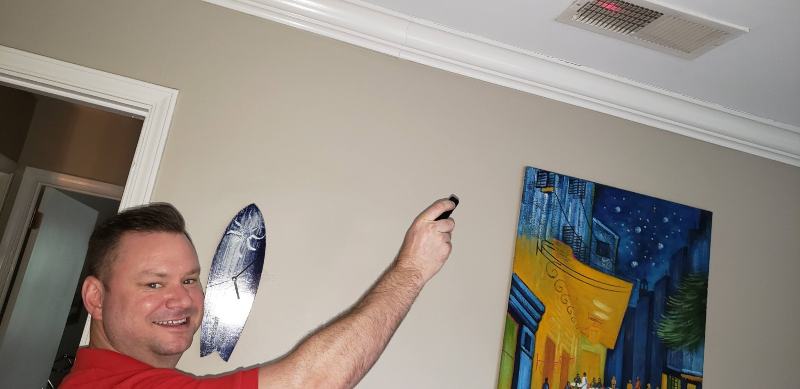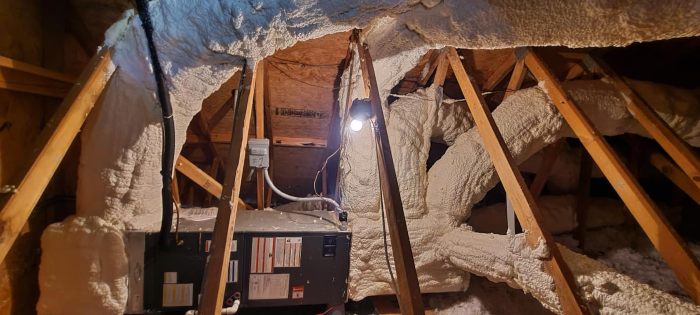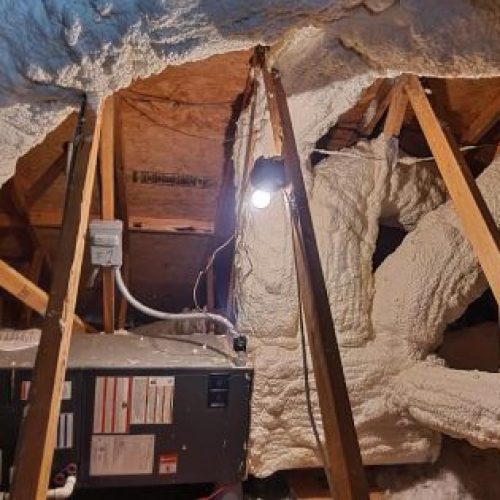Our definition of encapsulation is thus: The process of placing something within a capsule.
If your HVAC air ducts are located in your attic, you already know that it’s the worst possible place. You’d be better off with your hvac equipment and air ducts located in the front yard, rather than your attic!
For several years now, homeowners have gotten relief by sealing their rooflines with spray foam insulation. Spraying your roofline with spray foam insulation seals and insulates your entire attic space… much like a Yeti Cooler.
When the hvac system and air ducts are protected (encapsulated) in an attic that has been sealed with spray foam insulation, usually the results are immediate and dramatic: Comfort and efficiency!

However, for homeowners, there are risks associated with sealing your attic with spray foam insulation:
There could be a stubborn, lingering odor, especially in the summer months.
If the furnace is not a direct vent, high efficiency furnace, you need to consider a source of oxygen for the gas combustion.
Here in the southeast, high levels of humidity accumulating in the sealed attic are a stubborn issue that must be dealt with.
After twenty years in the business, these are the three most common issues that I faced daily with our spray foam clients.
We spent literally thousands and thousands of dollars studying and researching the best way to resolve these issues.
God to the rescue!
Then, I finally had a “heavenly moment” that completely shifted my thinking.
I’d been “burying ducts” under a thick layer of cellulose attic insulation as early as 2003, before spray foam attic insulation was as commonplace as it is now. The results I was getting were phenomenal for my clients!
We had also been spraying low-pressure, unheated closed cell foam insulation from that same time period in many thousands of occupied homes for the government. And we never had a single complaint nor comment regarding foul odors from the chemicals.
So we married those two experiences together, and began encapsulating air ducts using low pressure, unheated closed cell foam.
Literally we began spraying the entire air duct system with a thick layer of closed cell spray foam!
Our process solved two very big problems with these air duct systems:
– Sealed all of the air leaks. The U.S. Dept of Energy states that the average home is losing up to 30% of the airflow in the ducts, due to leaks!
– Vastly improved protection from the 140 degree inferno-like temperatures in the attic.

1 + 1 = 3
And we have the same results for our homeowners, as if the entire roofline was sprayed and sealed with spray foam insulation.
Except we have NONE of the risks associated with sealing and closing up an attic with foam!
This summer, do you want cooler air flowing from your air vents that have ducts in the attic? Consider having them sealed and insulated with our low-pressure closed cell spray foam insulation.
It’s called our “Instant Shade Tree”.
Like a Big Umbrella at the Beach!
But it won’t take you having to wait 30 years for the tree to grow. Your Instant Shade Tree service will take less than ½ a day!
And you will feel the results immediately before we even leave the house! Just like napping in the shade of your big umbrella at the beach!
What is better: Spraying the entire roofline and taking a gamble that you won’t smell the chemicals, or just spray the air ducts? Well, in my opinion, spraying the air ducts is the best way to go.
To monitor or not to monitor?
If you are the type of person who wants to move-on with life and not have to babysit the conditions in your attic, you don’t want to encapsulate the attic. Instead, encapsulate the air ducts.
After we spray your ducts with foam, there’s nothing else for you to be concerned with regarding the duct system and the spray foam. There are absolutely NO UNINTENDED CONSEQUENCES when we seal and insulate your air ducts with foam insulation! There is nothing to monitor.

Your Next Step Toward Risk-free, Instant Comfort
Do you want an immediate estimate for our Instant Shade Tree service? Here is what you’ll need:
- A good idea of the size of your attic. A rough estimate is fine.
- If your air ducts are located in the attic.
- If you have flat ceilings, tray ceilings, vaulted ceilings, just a yes/no answer.
- How many (if any) recessed light fixtures are in the ceiling that creates your attic floor.
You will immediately receive an estimate from Bird Family Insulation for your Instant Shade Tree:
- We’ll improve your attic insulation to R-50, using high-performance Bora Spray cellulose insulation.
- We Seal & Insulate your air duct system, using our safe low-pressure, unheated, closed-cell spray foam insulation protocol.
In 2020, our Instant Shade Tree average invoice was $5697.
Compare that to the cost of a full roofline encapsulation, and the associated risks and the hassle of solving any (expensive) future issue with those unintended consequences of sealing your attic with foam insulation.
You’ll probably agree, when you encapsulate your air ducts with the Instant Shade Tree service, it is the safest, wisest choice for your family!
Thanks for reading!
Bob Bird
Bird Family Insulation





